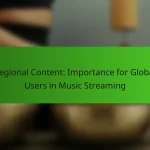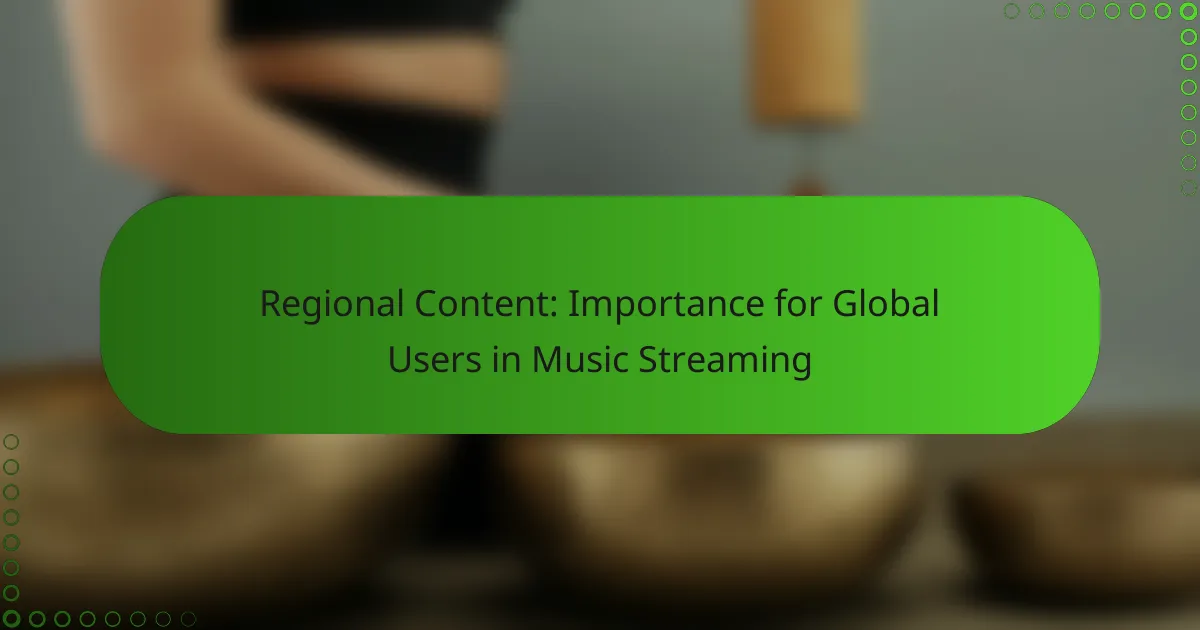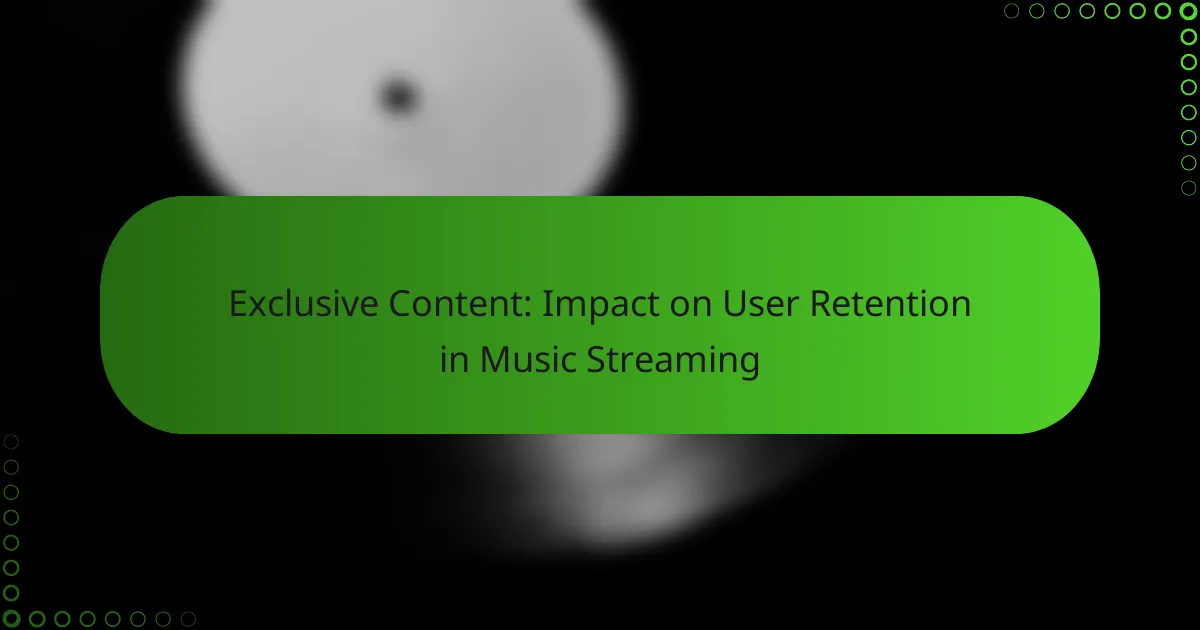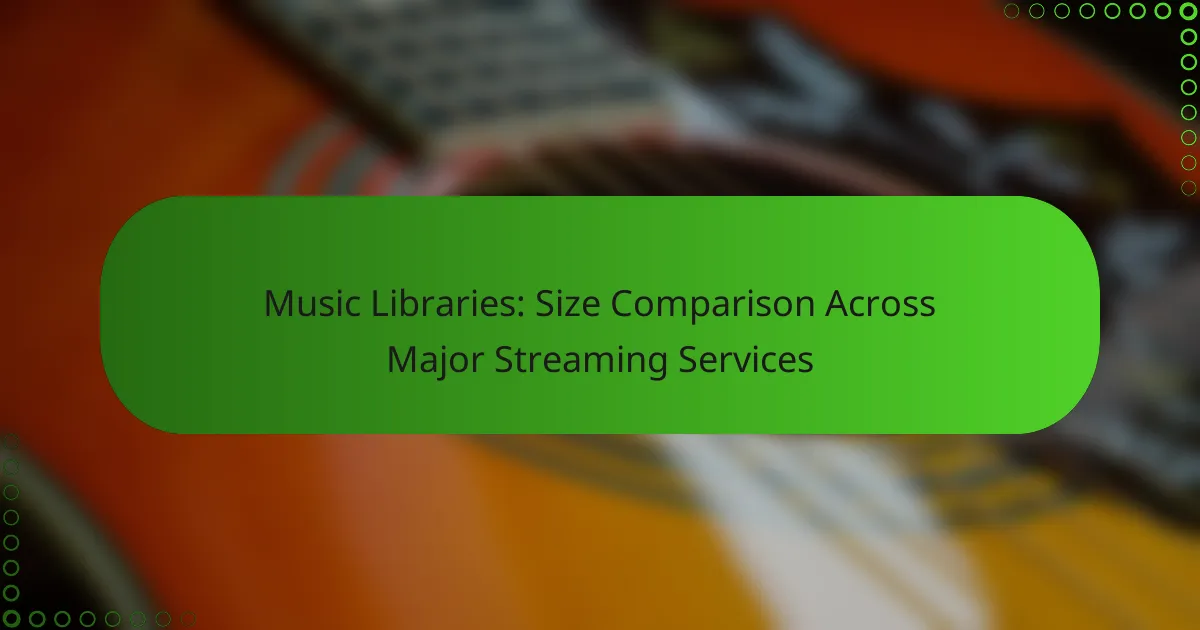Regional content plays a vital role in music streaming services by aligning offerings with local tastes and cultural preferences, ultimately boosting user satisfaction. By curating localized playlists and promoting regional artists, these platforms create a more personalized listening experience that fosters user loyalty and engagement.

Why is regional content important for music streaming services?
Regional content is crucial for music streaming services as it caters to local tastes and preferences, enhancing user satisfaction. By offering music that resonates with specific cultural contexts, these platforms can significantly improve user retention and loyalty.
Enhances user engagement
Providing regional content increases user engagement by making the listening experience more relatable. Users are more likely to explore and share music that reflects their cultural background, leading to longer listening sessions and more frequent app usage.
For example, a streaming service that features local artists and genres can create playlists tailored to regional celebrations or events, encouraging users to interact with the platform during those times.
Improves local relevance
Local relevance is achieved when music streaming services incorporate regional content that aligns with the interests and values of their users. This approach helps build a community around the platform, as listeners feel represented and understood.
Services that highlight local music trends or collaborate with regional influencers can foster a deeper connection with their audience, making them the go-to choice for music discovery in that area.
Boosts subscription rates
Offering regional content can lead to increased subscription rates as users perceive greater value in services that cater to their specific needs. When potential subscribers see a diverse catalog that includes their favorite local artists, they are more likely to commit to a paid plan.
For instance, platforms that provide exclusive access to regional concerts or events can attract users who are willing to pay for unique experiences that reflect their cultural identity.

How do music streaming platforms implement regional content?
Music streaming platforms implement regional content by curating music and features that resonate with local audiences. This includes creating localized playlists, promoting regional artists, and offering language-specific interfaces to enhance user experience.
Localized playlists
Localized playlists are collections of songs tailored to specific regions, reflecting local tastes and cultural trends. These playlists often feature popular tracks from local artists alongside international hits, making them relevant to the audience.
For example, a platform might create a playlist for users in Brazil that includes samba and bossa nova tracks, while a playlist for users in the UK might focus on indie rock and pop. Regular updates keep these playlists fresh and engaging.
Regional artist promotions
Regional artist promotions involve highlighting local musicians through features like artist spotlights, exclusive interviews, and promotional campaigns. This not only supports local talent but also encourages users to explore music that is culturally significant to their region.
Streaming services may collaborate with local festivals or events to promote these artists, offering exclusive content or live performances. This strategy helps build a community around regional music scenes.
Language-specific interfaces
Language-specific interfaces ensure that users can navigate the platform in their preferred language, enhancing accessibility and user satisfaction. This includes translating menus, descriptions, and notifications into the local language.
For instance, a platform operating in Spain might offer its interface in Spanish, while also providing content recommendations based on Spanish-speaking users’ preferences. This localized approach helps users feel more connected to the platform and its offerings.

What are the benefits of regional content for global users?
Regional content in music streaming offers global users tailored experiences that enhance their listening enjoyment. By providing access to local artists and genres, users can discover music that resonates with their cultural backgrounds and preferences.
Personalized listening experiences
Personalized listening experiences are a significant advantage of regional content. Streaming platforms often use algorithms that analyze user preferences, allowing them to recommend songs and artists from specific regions that align with individual tastes. This means users can enjoy a more curated playlist that feels uniquely theirs.
For instance, a user in Brazil may receive recommendations for local samba and bossa nova artists, while a listener in Sweden might discover emerging indie pop bands from their area. This tailored approach enhances user engagement and satisfaction.
Cultural connection through music
Regional content fosters a deeper cultural connection for global users. Music often reflects the traditions, stories, and emotions of a particular place, allowing listeners to experience and appreciate different cultures. This connection can be especially meaningful for expatriates or those living away from their home countries.
For example, a user from India living abroad can explore Bollywood hits or regional folk music, helping them stay connected to their heritage. This cultural immersion can enhance the overall listening experience and promote understanding among diverse audiences.
Access to local music trends
Access to local music trends is another key benefit of regional content. Users can stay updated with the latest hits and emerging artists in specific areas, which may not be widely known outside those regions. This access allows listeners to discover new sounds and genres that are gaining popularity.
For instance, a user interested in K-pop can follow the latest releases from South Korean artists, while someone in Nigeria can explore the growing Afrobeats scene. Being aware of these trends not only enriches the listening experience but also keeps users in the loop with global music movements.
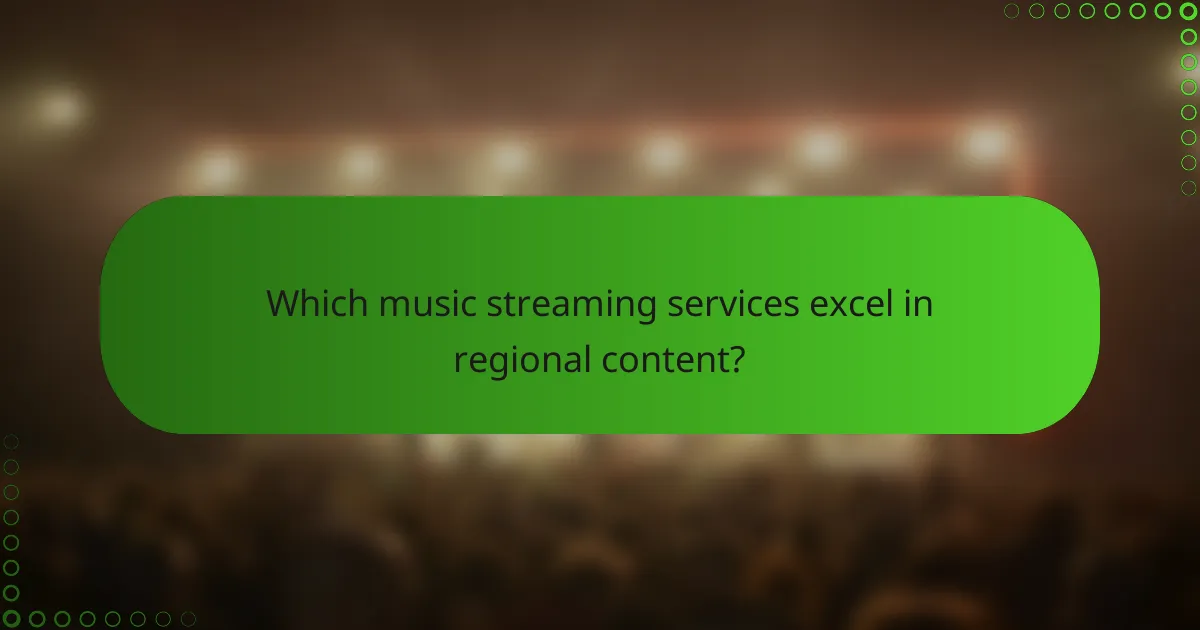
Which music streaming services excel in regional content?
Several music streaming services stand out for their focus on regional content, enhancing the listening experience for users worldwide. Spotify, Apple Music, and YouTube Music each offer unique features that cater to local tastes and preferences.
Spotify’s localized playlists
Spotify excels in providing localized playlists that reflect the music preferences of specific regions. These playlists are curated based on local trends, popular artists, and cultural events, making them highly relevant to users in different countries.
For example, users in Brazil can enjoy playlists featuring samba and bossa nova, while those in the U.S. might find playlists focused on hip-hop and pop. This tailored approach allows listeners to discover new music that resonates with their cultural background.
Apple Music’s regional charts
Apple Music offers regional charts that highlight the most popular songs in various countries. These charts are updated regularly, showcasing trending tracks and artists that are gaining traction locally.
For instance, users in the UK can access charts that feature the latest hits from British artists, while listeners in India can explore popular Bollywood tracks. This feature helps users stay connected to the music scene in their region.
YouTube Music’s local artist features
YouTube Music emphasizes local artists by featuring them prominently in its recommendations and playlists. This focus allows users to discover emerging talent from their area, fostering a sense of community and support for local musicians.
For example, users in South Africa may find playlists dedicated to local genres like kwaito or amapiano, while those in Japan can explore J-pop artists. By promoting local talent, YouTube Music enhances the cultural relevance of its offerings.
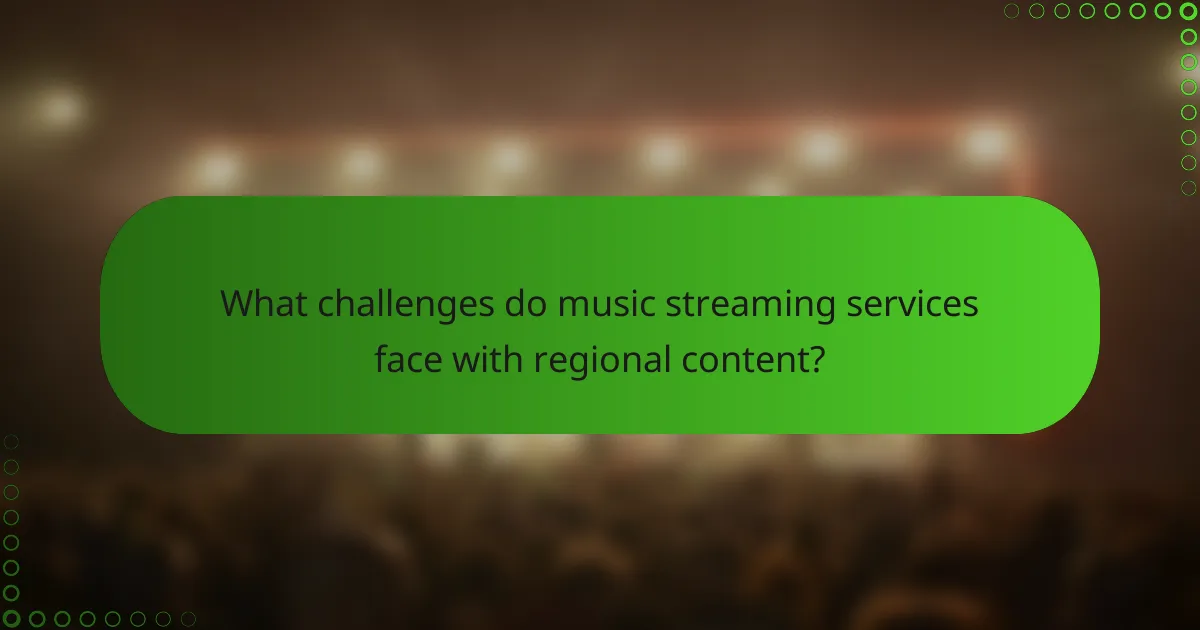
What challenges do music streaming services face with regional content?
Music streaming services encounter several challenges related to regional content, primarily revolving around licensing, audience preferences, and the need to balance global and local offerings. These factors can significantly impact their ability to provide a comprehensive and appealing catalog to users across different regions.
Content licensing issues
Content licensing is a major hurdle for music streaming platforms, as they must negotiate rights with record labels and artists in each region. These agreements can vary widely, leading to inconsistencies in available music across countries. For instance, a popular album may be accessible in the US but not in Europe due to licensing restrictions.
Additionally, the complexity of copyright laws can complicate these negotiations. Streaming services must ensure compliance with local regulations, which can differ significantly from one country to another, affecting their catalog and user experience.
Balancing global and local offerings
Finding the right balance between global hits and local music is crucial for streaming services. Users often seek familiar international tracks while also wanting to discover local artists and genres. Services must curate playlists that reflect this dual demand, which can require substantial market research and user feedback.
For example, a service might feature a global pop star’s latest album while simultaneously promoting regional artists to cater to local tastes. This approach not only enhances user satisfaction but also supports local music scenes.
Understanding diverse audience preferences
Music streaming services must navigate a wide array of audience preferences that vary by region. Cultural influences, language, and even local trends can shape what users want to listen to. Understanding these nuances is essential for effective content curation.
To address this, services often employ data analytics to track listening habits and preferences in different regions. This information helps them tailor recommendations and playlists, ensuring they resonate with local audiences while still offering a diverse selection of music.
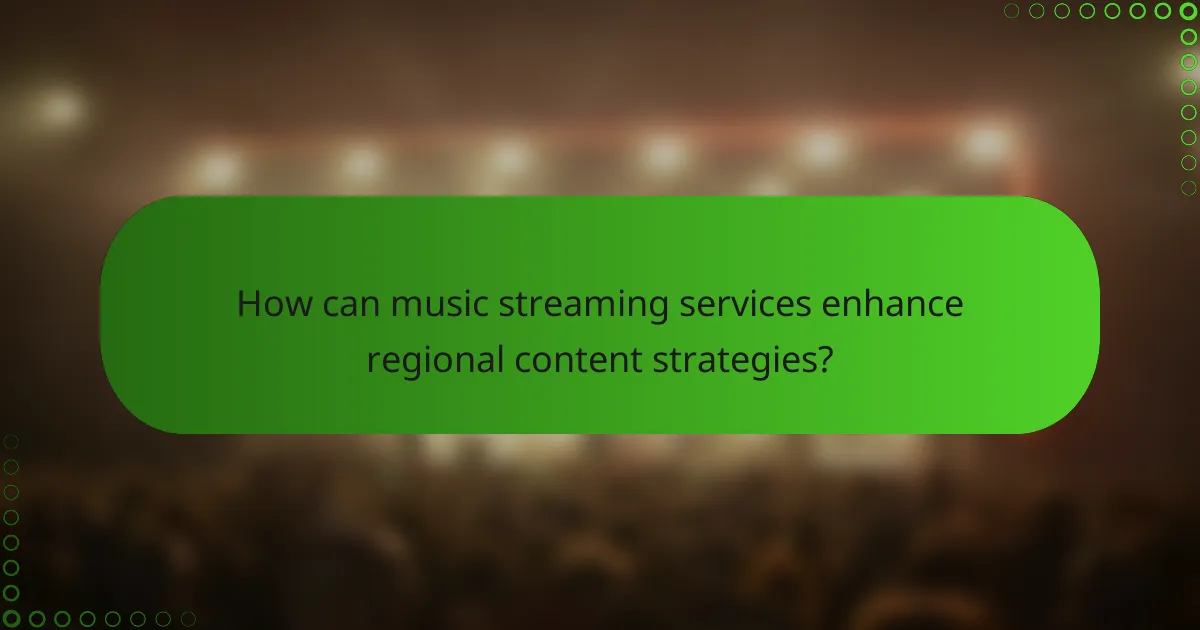
How can music streaming services enhance regional content strategies?
Music streaming services can enhance regional content strategies by tailoring their offerings to local tastes and preferences. This involves leveraging user data, collaborating with local artists, and investing in targeted marketing campaigns that resonate with specific audiences.
Utilizing user data analytics
By analyzing user data, music streaming services can gain insights into regional listening habits and preferences. This data helps identify popular genres, emerging artists, and specific tracks that resonate with local audiences.
Services can implement algorithms that recommend music based on regional trends, ensuring users receive personalized content. Regularly updating these analytics allows platforms to adapt to changing tastes and maintain user engagement.
Collaborating with local artists
Partnering with local artists is crucial for music streaming services to build credibility and connect with regional audiences. By promoting local talent, platforms can create a sense of community and foster loyalty among users.
These collaborations can take various forms, such as exclusive releases, live performances, or curated playlists featuring local artists. This not only enriches the content library but also supports the local music scene.
Investing in regional marketing campaigns
Effective regional marketing campaigns are essential for promoting localized content. Streaming services should consider using local languages, cultural references, and regional influencers to enhance their outreach.
Investing in targeted advertisements on social media and local media channels can significantly increase visibility. Additionally, hosting local events or sponsoring music festivals can further engage potential users and strengthen brand presence in the region.




